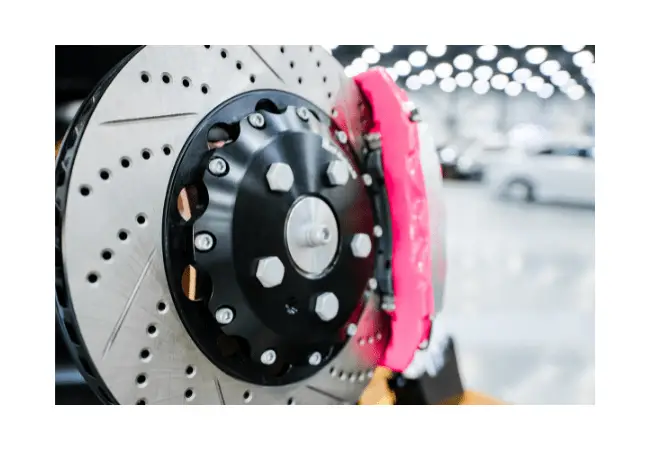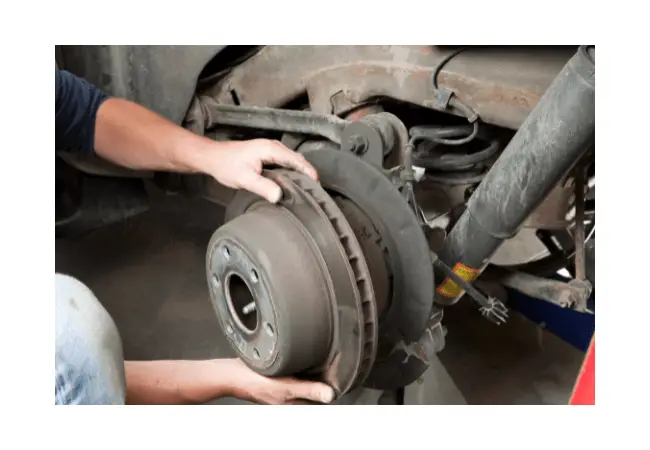Brakes are an essential component of any vehicle, playing a crucial role in ensuring the safety of passengers and other road users. Without a properly functioning brake system, drivers would be unable to slow down or stop their vehicles effectively, leading to potentially disastrous consequences.
Brakes are particularly important in emergency situations, where a quick and precise response can mean the difference between a minor incident and a serious accident. Therefore, it is vital to ensure that your vehicle’s brake system is regularly inspected and maintained to ensure maximum safety and performance.
What are brake rotors – they are an essential component of the brake system, providing the surface against which the brake pads create friction to slow down and stop the vehicle. Brake rotors are typically made from high-strength materials such as cast iron, steel, or ceramic composites, and are designed to withstand the high levels of heat and stress generated during the braking process.
There are several types of brake rotors, including vented, drilled, and slotted rotors, each designed to provide specific performance benefits depending on the intended use of the vehicle. Regular inspection and maintenance of brake rotors are essential to ensure optimal braking performance and safety on the road.
The brake system of a vehicle is made up of several components that work together to slow down and stop the vehicle when the brakes are applied. The main components of a brake system include the brake pedal, brake lines, brake calipers, brake pads, and brake rotors.
When the driver presses the brake pedal, hydraulic pressure is created, which is then transmitted through the brake lines to the brake calipers. The calipers then squeeze the brake pads against the brake rotors, creating friction that slows down the vehicle. The heat generated by this friction is then dissipated by the brake rotors, allowing the vehicle to come to a complete stop.
Contents
What Are Brake Rotors

A brake rotor, also known as a brake disc, is a flat, circular component that is part of the disc brake systems of a vehicle. It is attached to the wheel hub and rotates with the wheel, providing a surface for the brake pads to clamp onto when the brakes are applied. The brake rotor converts the kinetic energy of the moving vehicle into heat energy through friction, allowing the vehicle to slow down and come to a stop.
The primary function of brake rotors in the brake system is to provide a surface against which the brake pads can create friction, generating the force required to slow down and stop the vehicle. When the brakes are applied, the brake calipers squeeze the brake pads against the brake rotors, creating friction that converts the kinetic energy of the moving vehicle into heat energy. This heat is then dissipated through the brake rotors, allowing the vehicle to slow down and come to a stop.
There are several types of brake rotors available on the market, each designed to provide specific performance benefits depending on the intended use of the vehicle. Vented brake rotors feature internal vanes or fins that help to dissipate heat more efficiently, making them ideal for high-performance vehicles. Drilled brake rotors have holes drilled into them, which help to reduce the buildup of heat and gases, improving brake performance and reducing the risk of brake fade. Slotted brake rotors have slots machined into them, which help to remove brake dust, water, and debris from the surface of the rotor, improving the overall performance of the brake system.
Brake rotors are typically made from high-strength materials such as cast iron, steel, or ceramic composites. Cast iron is the most common material used in brake rotor manufacturing, offering a good balance of strength, durability, and cost-effectiveness. Steel brake rotors are more expensive than cast iron but offer better performance in high-temperature environments. Ceramic composite brake rotors are the most expensive option, offering the best performance in terms of heat dissipation and durability.
The material used in the manufacturing of brake rotors depends on the intended use of the vehicle and the desired performance characteristics of the brake system.
How do Brake Rotors Work
When a driver applies the brakes, hydraulic pressure is created, which causes the brake calipers to squeeze the brake pads against the brake rotors. The friction created between the brake pads and the brake rotors converts the kinetic energy of the moving vehicle into heat energy, which is then dissipated through the brake system. The process of braking is a complex one that requires a delicate balance between the various components of the brake system to ensure effective braking performance.
The brake rotors play a crucial role in the process of braking by providing a surface for the brake pads to create friction against the brake rotor. As the brake pads are pressed against the brake rotors, the kinetic energy of the moving vehicle is converted into heat energy, which is then dissipated through the brake system.
The brake rotors must be strong enough to withstand the high levels of heat and stress generated during the braking process, and they must also be able to dissipate this heat efficiently to prevent overheating and brake fade.
The ability of brake rotors to dissipate heat efficiently is crucial to their performance in the brake system. Brake rotors are typically designed with internal cooling vanes or fins, which help to increase the surface area of the rotor and promote the efficient transfer of heat away from the braking surface.
Some types of brake rotors, such as drilled and slotted rotors, are designed to enhance heat dissipation by allowing for better airflow through the rotor and reducing the buildup of heat and gases.
The performance of the brake rotors is directly linked to the overall performance of the brake system. High-quality brake rotors are designed to dissipate heat efficiently and withstand the high levels of stress generated during braking will provide better braking performance and reduce the risk of brake fade.
The type of brake rotors used in a vehicle can also affect the overall performance of the brake system, with some types of rotors offering improved performance in specific conditions or applications. Regular inspection and maintenance of brake rotors are essential to ensure optimal braking performance and safety on the road.
Signs of Brake Rotor Wear
Brake rotors are subjected to high levels of stress and heat during the braking process, which can lead to wear and tear over time. The most common cause of brake rotor wear is the constant friction generated between the brake pads and the rotor, which can cause the rotor to become thinner and eventually lead to warping or cracking.
Other factors that can contribute to brake rotor wear and tear include exposure to moisture, road salt, and other corrosive substances.
There are several common signs of worn brake rotors that drivers should be aware of. One of the most noticeable signs of worn brake rotors is vibrations or pulsations felt in the brake pedal or steering wheel when the brakes are applied. This can be caused by uneven wear on the brake rotor or warping of the rotor due to overheating.
Another common sign of worn brake rotors is noise, such as squeaking, grinding, or groaning, when the brakes are applied. Finally, reduced braking power is another sign of worn brake rotors, as the brake pads may not be able to create enough friction against the rotor to slow down the vehicle effectively.
Regular inspection and maintenance of brake rotors are essential to ensure optimal braking performance and safety on the road. Brake rotors should be inspected for wear and tear regularly, typically during routine maintenance intervals or whenever any signs of wear or damage are detected.
If the brake rotors are found to be worn or damaged, they should be replaced immediately to prevent further damage to the brake system and ensure maximum braking performance. Regular maintenance of the brake system, including cleaning and lubrication of the brake components, can also help to extend the life of the brake rotors and ensure reliable and safe braking performance.
Brake Rotor Replacement

Brake rotors should be replaced when they are worn beyond their safe operating limit, which varies depending on the type of rotor and the vehicle’s usage. A general rule of thumb is that brake rotors should be replaced when they are less than the manufacturer’s recommended thickness, or when they show signs of wear such as warping or cracking.
In some cases, brake rotors may also need to be replaced if they are corroded, contaminated, or damaged in any way that affects their performance or safety.
The process to replace your rotors typically involves several steps, including removing the wheel and tire, removing the brake caliper and brake pads, removing the worn rotors, installing the new brake rotor, and reassembling the brake system.
It is important to follow the manufacturer’s recommended procedures for brake rotor replacement to ensure the safe and proper functioning of the brake system. Professional installation is recommended, as incorrect installation can lead to brake failure and other safety issues.
Using high-quality brake rotors is essential for ensuring the safe and reliable operation of the brake system. High-quality brake rotors are made from strong and durable materials that can withstand the high levels of stress and heat generated during braking, and they are designed to dissipate heat efficiently to prevent brake fade.
Using low-quality or substandard brake rotors can compromise the safety of the vehicle and lead to premature wear and failure of the brake system.
The cost to replace worn rotors can vary depending on several factors, including the make and model of the vehicle, the type of brake rotors being used, and the cost of labor. Generally, brake rotors wear replacement costs can range from a few hundred dollars to several thousand dollars, with high-performance or specialized brake rotors being more expensive than standard rotors.
While the cost of brake rotor replacement may seem high, it is essential to ensure the safe and reliable operation of the brake system, and neglecting brake rotor maintenance or replacement can lead to much higher costs in the long run.
Conclusion
Brake rotors are a crucial component of the brake system, playing a key role in converting kinetic energy to heat energy during the braking process. They provide the surface against which the brake pads create friction, slowing down and stopping the vehicle.
Properly functioning brake rotors are essential for the safe and reliable operation of the brake system, and regular maintenance and replacement are necessary to ensure optimal performance and safety on the road.
Regular brake maintenance is essential to ensure the safe and reliable operation of the brake system, including the brake rotors. Routine maintenance can help to detect and address any issues or signs of wear before they become more serious, reducing the risk of brake failure and other safety issues.
Maintenance tasks may include inspecting and replacing brake pads, cleaning, and lubricating brake components, checking brake fluid levels, and inspecting and replacing brake rotors as needed.
Brake rotors are an essential component of the brake system, providing the surface for the brake pads to create friction and slow down the vehicle. They are subjected to high levels of stress and heat during the braking process, and regular maintenance and replacement are necessary to ensure optimal performance and safety.
It is important to use high-quality brake rotors and to follow the manufacturer’s recommended procedures for maintenance and replacement to ensure the safe and reliable operation of the brake system. Neglecting brake maintenance or using low-quality brake rotors can compromise the safety of the vehicle and lead to much higher costs in the long run.
